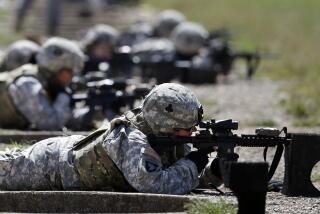Women: All That They Can Be
It has been more than a decade since the Women’s Army Corps (WACS) was integrated into the Army, but the sight still caused a double-take among many who saw news coverage of the Panama invasion: Under some of those helmets were women.
Then came the story of Army Capt. Linda Bray, who commanded a military police unit that was involved in a brief firefight with troops of the Panama Defense Forces. It turned out that the initial reports of the battle were overblown, but the story itself was enough to renew the “women in combat” debate. Rep. Pat Schroeder (D-Colo.) has already announced that she will introduce legislation that would allow women in the Army to take part in all military activities, including combat, for a test period. The idea deserves support.
The Schroeder proposal is expected to be modeled after a recommendation by a Pentagon advisory board, which last fall suggested a 4-year trial period for women in combat. Women make up about 11% of the nation’s active-duty personnel, and already qualify for 88% of all military job classifications. But they hold only 56% of actual positions because there are large numbers of soldiers assigned to combat-related jobs that are barred to women. Women are not protected from otherwise dangerous military assignments; but a lack of combat duty has kept them from promotions, particularly in officer ranks.
Helen Rogan, in her 1981 book “Mixed Company,” outlined the typical arguments against women in combat:
Critics say that “women have become associated with all that is wrong in the Army; some feel if things were going well, there would not have to be all those women around with their hair straggling out from their caps. There would be no pregnancies, no tales of harassment. Many male soldiers see the encroaching women as part of the gradual erosion of the prestige and power of the old Army . . . . Congress has periodic seizures about females coming home in body bags. Conservative columnists furiously ask: ‘Do we want coeds at the Khyber?’ ”
But it was not so long ago that similar arguments were made to keep women out of municipal fire and police departments. After some legal prodding, however, departments found ways to recruit women who turned out to be successful cops and firefighters. We will hear all of the arguments again and again. But to be fair, it’s hard to argue with a limited test run.
More to Read
Sign up for Essential California
The most important California stories and recommendations in your inbox every morning.
You may occasionally receive promotional content from the Los Angeles Times.










